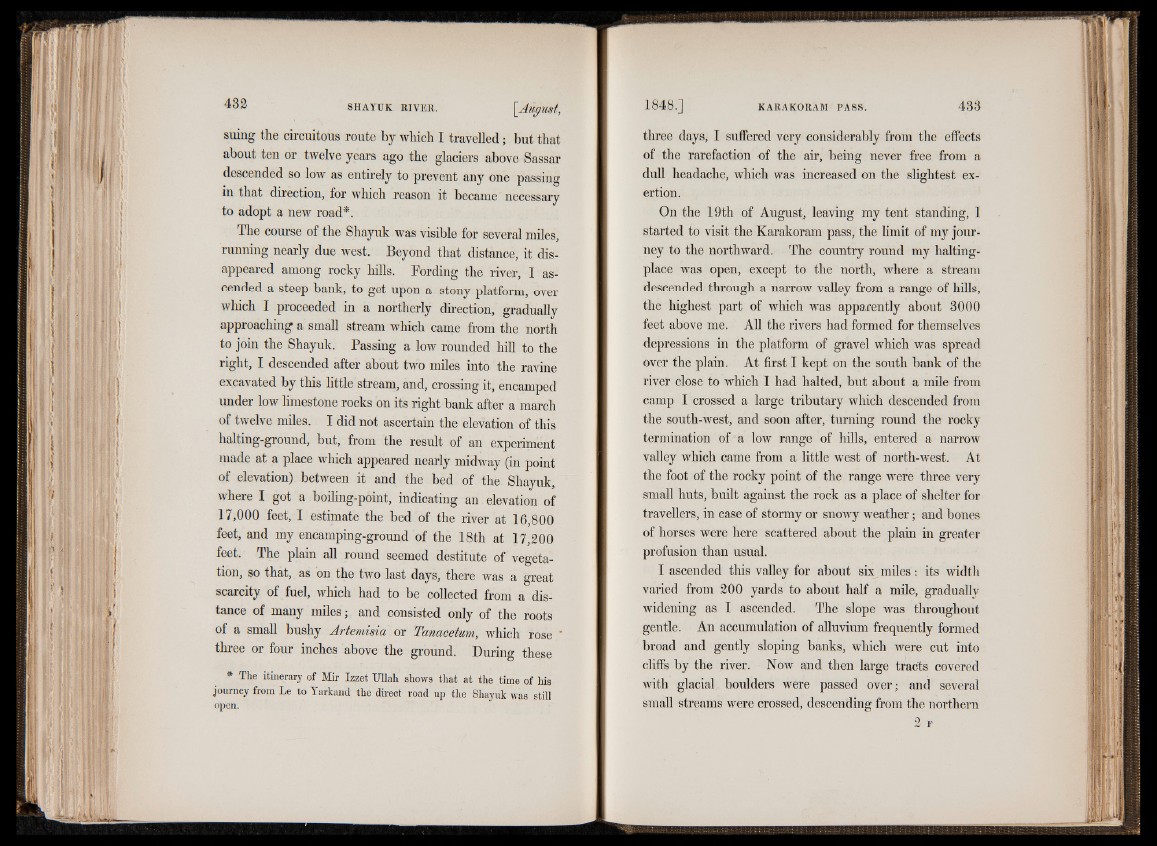
suing the circuitous route by which I travelled; but that
about ten or twelve years ago the glaciers above Sassar
descended so low as entirely to prevent any one passing
in that direction, for which reason it became necessary
to adopt a new road*.
The course of the Shayuk was visible for several miles,
running nearly due west. Beyond that distance, it disappeared
among rocky hills. Fording the river, I ascended
a steep bank, to get upon a stony platform, over
which I proceeded in a northerly direction, gradually
approaching a small stream which came from the north
to join the Shayuk. Passing a low rounded hill to the
right, I descended after about two miles into the ravine
excavated by this little stream, and, crossing it, encamped
under low limestone rocks on its right bank after a march
of twelve miles. I did not ascertain the elevation of this
halting-ground, but, from the result of an experiment
made at a place which appeared nearly midway (in point
of elevation) between it and the bed of the Shayuk,
where I got a boiling-point, indicating an elevation of
17,000 feet, I estimate the bed of the river at 16,800
feet, and my encamping-ground of the 18th at 17,200
feet. The plain all round seemed destitute of vegetation,
so that, as on the two last days, there was a great
scarcity of fuel, which had to be collected from a distance
of many miles; and consisted only of the roots
of a small bushy Artemisia or Tanacetum, which rose *
three or four inches above the ground. During these
* The itinerary of Mir Izzet Ullah shows that at the time of his
journey from Le to Yarkand the direct road up the Shayuk was still
open.
three days, I suffered very considerably from the effects
of the rarefaction of the air, being never free from a
dull headache, which was increased on the slightest exertion.
On the 19th of August, leaving my tent standing, I
started to visit the Karakoram pass, the limit of my journey
to the northward. The country round my halting-
place was open, except to the north, where a stream
descended through a narrow valley from a range of hills,
the highest part of which was apparently about 3000
feet above me. All the rivers had formed for themselves
depressions in the platform of gravel which was spread
over the plain. At first I kept on the south bank of the
river close to which I had halted, but about a mile from
camp I crossed a large tributary which descended from
the south-west, and soon after, turning round the rocky
termination of a low range of hills, entered a narrow
valley which came from a little west of north-west. At
the foot of the rocky point of the range were three very
small huts, built against the rock as a place of shelter for
travellers, in case of stormy or snowy weather; and bones
of horses were here scattered about the plain in greater
profusion than usual.
I ascended this valley for about six miles: its width
varied from 200 yards to about half a mile, gradually
widening as I ascended. The slope was throughout
gentle. An accumulation of alluvium frequently formed
broad and gently sloping banks, which were cut into
cliffs by the river. Now and then large tracts covered
with glacial boulders were passed over; and several
small streams were crossed, descending from the northern